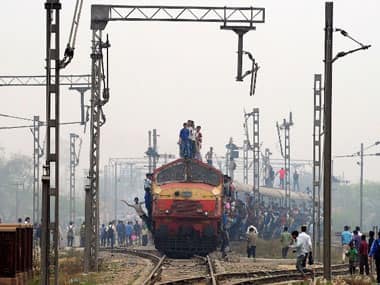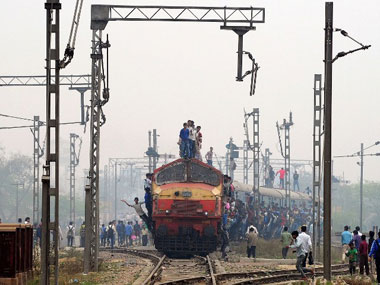Railway minister Suresh Prabhu’s first budget may be aspirational but it has to be taken with a pinch of salt as some of his ambitious projections and plans are based on unrealistic assumptions, experts have warned. The minister in the budget presented yesterday played safe by not announcing new trains, which helped him stay away from populism, but promised many consumer friendly initiatives for the common man and also projected a humongous Rs 8.5 lakh crore investment in the next five years. He has also assumed an ambitious improvement in traffic revenues and efficiency for the next financial year, which has painted a robust outlook for the sector. [caption id=“attachment_2125079” align=“alignleft” width=“380”]  AFP[/caption] The big numbers and right noises have made both investor community and the common man happy but a closer look at the assumptions of his projections would leave one wondering whether they are too optimistic given the economy is still struggling. Though sector experts and analysts are all praise for the budget, they have not refrained from raising a warning about the underlying unrealistic assumptions. Dhananjay Sinha of brokerage firm Emkay has said that the minister’s projections are based on expectation of a sharp rebound in the economy and the railways’ ability to leverage the expected decline in fuel costs and higher cost efficiency. Sinha’s first caution is about the estimated 15.7 percent increase in gross traffic receipts (including freight, passenger, coaching and others) to Rs 1.84 lakh crore for 2015-16. The contribution of freight is estimated to be 65 percent at Rs 1.21 lakh crore. This assumes a 13.6 percent rise over the current year. Sinha estimates that to achieve this, freight volumes should grow 7.9 percent next year and average tariff realisation 5.7 percent. The 7.9 percent volume growth, Sinha notes, will be more than double that of 3.2 percent recorded this year. A better comparison would be the six-year average, which stands at a lowly 4 percent. “The budget assumes roughly uniform 7-8% growth in freight volume across various segments, but notably pig iron & finished steel, cement, iron ore and food grains are contributing significant to the overall growth. Freight hike for containers are assumed to rise by a substantial 20%,” he has noted. The Indian Railways’ freight traffic has a direct correlation to the economic activity since it carries commodities that are mostly related to the infrastructure sector. Only a revival in construction and infrastructure sectors will increase demand for coal, cement and other commodities, and push the freight volumes up. Given the current situation, one cannot expect a dramatic turnaround in these sectors next year. So also the railways’ freight traffic. The projections on passenger traffic revenue are also not very different. “…The FY16 passenger earning growth target is optimistic in the wake of no increase in passenger fare. The passenger earning growth in FY15 was achieved on the back of fare and tariff revision in June 2014,” India Ratings has said in a post. As per the budget numbers, earnings from the passenger traffic is estimated to have increased 17.7 percent to Rs 43,002 crore in 2014-15. This is despite a 3.6 percent decline in volumes, which Emkay attributes to a 21.3 percent tariff hike that kept travellers away from railways. For the next year, the budget projects earnings from passenger traffic to rise 16.7 percent to Rs 50,175 crore. To achieve this, the volumes should grow 6 percent and tariff 10.7 percent. But the increase in tariff, without which the railways will not be able to meet the projected earnings growth, is likely to make rail travel unattractive and put off travellers. This will negatively impact volumes as it did in 2014-15, and so meeting the passenger earnings target will be an uphill task. Another ambitious target that the minister has set is the more than 3 percentage point improvement in operating ratio. Operating ratio is a key metric that measures the efficiency of railways. The railways’ operating ratio for 2014-15 is estimated to be 91.8 percent. This means of Re 1 it earned, 91.8 paise is utilised to meet various expenses and only 8.2 paise has been saved. The minister wants to improve this ratio to 88.5 percent next year. To achieve this target, the railways will have to aggressively contain its working expenses. As per the white paper published by the minister yesterday, the share of various components in the railways’ expenditure has remained by and large constant over the four years until 2013-14. Staff costs form the bulk of it, followed by fuel, pensions and payments towards Indian Railways Finance Corporation (for the borrowings it does on behalf of the railways). In 2013-14, staff costs formed 35.07 percent of railways’ spending, fuel 22.26 percent, pensions 18.67 percent and IRFC 4.45 percent. In 2014-15, the fuel expenses might have seen (data not given) a decline in tandem with global crude prices. The minister seems to expect this to continue and help him in meeting the operating ratio target. But a closer look reveals he might be expecting too much. First and foremost, that diesel prices will remain lower is just an assumption. What if things reverse? More importantly, how long will they remain low? One cannot expect this to continue for ever. Once the trend reverses, the railways will have to bear the brunt. The next component is pension. Like many other public sector undertakings, railways also has more pensioners than its staff: 13.64 lakh as against 13.07 lakh (as of 31 March 2013). The pensioners are seen growing at a scorching pace over the next decade, when 5 lakh staff are expected to retire incrementally. In 2014-15, the pension outgo is estimated to have grown over 17 percent year on year to Rs 28,550 crore. For the next year, the outgo is estimated to grow another 17.5 percent to Rs 33,546 crore (source white paper). Higher the pension outgo, higher the expenses. Lastly, the minister’s aggressive fund raising plan will also have a bearing on the expenses. As per the the budget, the railways’ market borrowing next financial year will be Rs 17,650 crore, a good 46.5 percent over this year. This will definitely increase the payment towards IRFC, which has been increasing almost steadily over the last few years. In 2010-11, IRFC payment formed 3.96 percent of the railways’ spending, which hit 4.45 percent in 2013-14. Given the investment plan laid out by the minister, the borrowing will only increase. Given all these factors, reining in the working expenses of the railways will be a hard task for the minister and so the 88.5 percent operating ratio looks too unrealistic at this point in time, unless economy turns around and consumer confidence returns dramatically.
Meeting the projections looks too unrealistic at this point in time, unless economy turns around and consumer confidence returns dramatically
Advertisement
End of Article


)

)
)
)
)
)
)
)
)



